When the Berlin Wall fell in November 1989, the song “Wind of Change” by the Scorpions (video below) accompanied the moving scenes of East Germans passing through the Brandenburg Gate and entering the West for the first time. In Prague, the song summed up the sentiment of the peaceful velvet revolution when thousands demonstrated for the end of communist rule. It’s a song with a lot of memories for me. It was the second song played at my wedding, just after Louis Armstrong’s “What a Wonderful World”. Somewhere between those two songs is where I dwell: a person who really does believe that the world can, and should, change, and that if we don’t all keep working at it relentlessly, it won’t be a change for the better.
Back then, I was pretty sure that we were pointed in the right direction. The dissolution of the Soviet Union. Perestroika. Glasnost. The end of the cold war. The release of Nelson Mandela from prison. The end of Apartheid. Maybe we weren’t going to need bomb shelters, after all.
That optimism is challenged at times. It seems a bit surreal to be doing a fitness challenge centred walking the space around the Berlin Wall this month. Russia is invading the Ukraine while I walk the 48 kilometre journey through the center of Berlin, Germany, from Waltersdorfer Chaussee to Hermsdorf. What used to be a symbol of a world split in half by the Cold War was turned into a symbol of freedom, liberty, and unity. But what have we learned from all of that? It seems like we have been living through year after year of new walls, underscoring the degree to which globalization and economic dislocation have bred resentment, anxiety, and xenophobia.
I finished this challenge, I did the distance, but I really don’t know which way the world is pointed today. The back of the medal says, “Many small people, who in many small places do many small things, can alter the face of the world.” That slogan was painted by artists Muriel Raoux and Kani Alavi on the gallery in 1990.
What action should I take, today? It’s hard not to feel small in the face of the unrelenting bad news.
Winds of Change by the Scorpions
Postcards
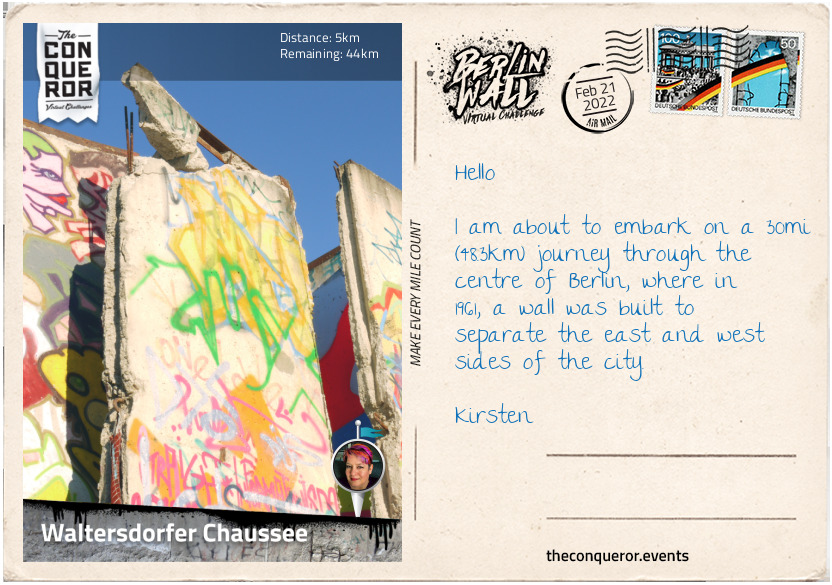
The thriving city of Berlin is home to 3.8 million people. It is the capital city of Germany, the largest city in the country and one of the most populated in Europe. A tourist destination, Berlin is rich with culture, diverse architecture, vibrant nightlife, a plethora of festivities and a very high quality of life.
Yet not so long-ago, Berlin was a decimated city, a result of heavy bombing during WWII. When Germany lost the war in 1945, the country was divided by the Allies into four sectors. The Allies consisted of the United States, Great Britain, France and the Soviet Union (USSR). East Germany was occupied by the USSR and West Germany was split between the other three. Berlin, as the capital city, was located in East Germany and it too was carved up into East and West Berlin.
Movement within the capital and around other parts of the country was easily accessible. For years, people were able to travel across borders for education, work, visiting family and so on without worry of being stopped.
Whilst West Germany was rebuilding quickly, improving the residents’ quality of life, East Germany was lagging behind and the Soviets became increasingly concerned when large numbers of its population were defecting to the west, particularly professionals, thereby causing a ‘brain drain’. To stem the tide, the Soviets closed their borders to West Germany but the border in Berlin remained open. The East Berliners swiftly took advantage of this opportunity to escape and by 1961 more than 300,000 had left within the first six months of the year.
Border crossing came to an end in August 1961 when the Soviets laid more than 6,000mi (9,600km) of barbed wire around West Berlin’s 96mi (156km) perimeter. The first generation of concrete walls was built within the same year, with subsequent fortifications following over the next 14 years. A secondary wall was built about 100m from the first one with the gap between them becoming what was known as the ‘death strip’.
Overnight, families, friends and neighbours were separated. East Berliners whose homes crossed the boundary between East and West found themselves with their back door nailed shut and bricked over. Many were relocated as buildings were razed to make way for the ‘death strip’. Waltersdorfer Chausse, where my journey begins, was a border crossing for West Berliners/Germans and foreigners heading to Schönefeld Airport in East Germany. The airport was the site of a daring escape by a couple, who hijacked a domestic flight shortly after take-off and tried to force the crew to fly to West Germany. The plan failed. When the couple realised they were landing back at the airport they killed themselves. In their words “All we want is to live our own lives the way we would like… Should our plan fail, [we] are going to depart this life… Death is then the best solution.”
Stories of bold escapes and failed attempts will unfold as I head north along the Berlin Wall Trail.
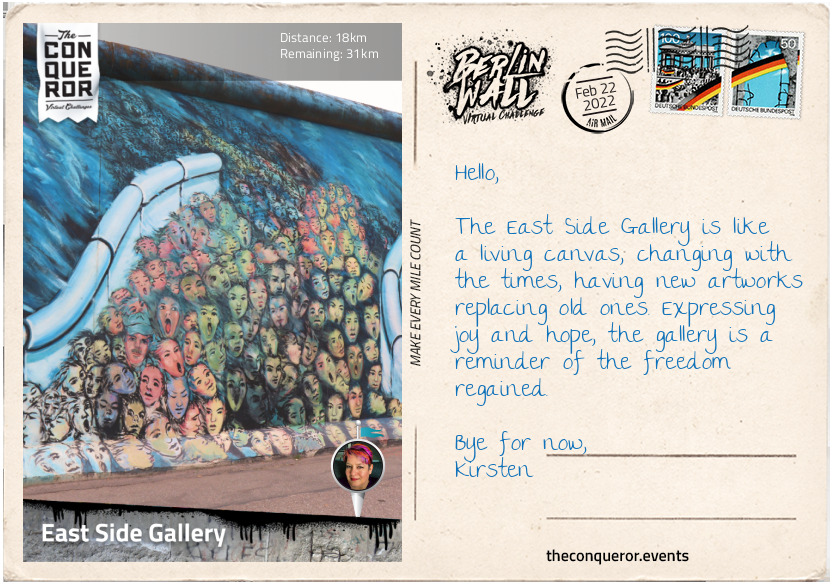
The Berlin Wall Trail was completed in 2006 and runs along the original borders. Storyboards of events are set along the route giving an insight into the division that occurred in Germany and the rise and fall of the Wall.
As I journey on the trail, I am touched by the courage shown by the men and women who fought for their freedom. Of those who have fallen, nearly half of the deaths took place in the first five years of the Wall’s existence and nearly 60% of them were in their early 20s. The escapees during these early years were from a generation who experienced freedom and open borders. Many of them used to commute to West Berlin for work and to visit their families.
With tightened border controls and enhanced fortifications, by the late 1960s, the number of escapees dropped significantly. People were so driven to find a better life that all manners of escape were undertaken. Some braved the ‘death strip’, attempting to climb the walls, others swam or dived the Spree River. Cars, trucks and trains were used to ram through borders or attempt to smuggle people across. Even more daring escapes were in a hot air balloon, tightrope walking and zip lining.
After the fall of the Berlin Wall, a section of the concrete wall was preserved and turned into an open-air gallery. At 4,300ft (1,300m) long, it is the longest outdoor gallery in the world. In 1990, a group of artists from 21 countries were invited to paint the wall with 106 works of art. The original artworks were an expression of the changing political times and joy over the fall of the Wall. A year later the gallery was designated a historical monument.
Time and vandalism damaged the Wall until 2009 when it was completely restored and the original artists were invited to return and repaint their works in more resistant colours. The other side of the wall was repainted white, restoring it to its pre-1989 condition when the colour, casting shadows of potential escapees, was supposed to alert border guards on watch.
Today, the gallery is one of the most visited landmarks in Berlin, drawing 800,000+ visitors per year.
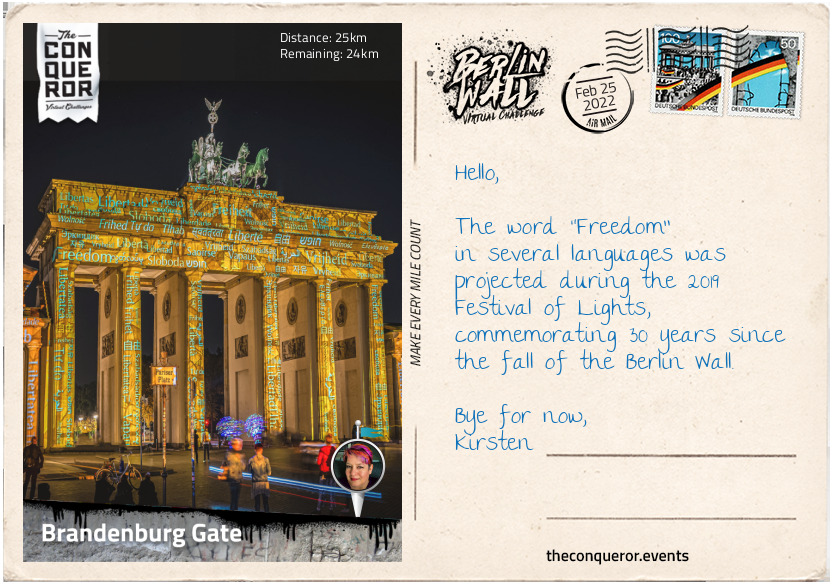
Within a mile of each other are two very important historical features that played crucial parts in Berlin’s history: Checkpoint Charlie and Brandenburg Gate.
Checkpoint Charlie was a major border crossing between East and West Berlin and the only crossing accessible to foreigners and Allied forces. A mere wooden shack, the checkpoint was in complete contrast to East Berlin’s side that featured guard towers, barriers and a shed to check vehicles for hidden escapees. The simple shack was meant to illustrate that the Berlin Wall was not a legal international border and that the checkpoints were meant to be temporary.
In October 1961, a US diplomat crossing into East Berlin was requested to have his documents examined by East Germans. He refused on the grounds that as per the US-USSR agreement, only Soviets were authorised to check documents. The diplomat was denied entry. Repeated efforts to restrict access to American personnel followed, culminating with a tank stand-off between the two superpowers at Checkpoint Charlie. Over a 24 hour period, the American and Soviet tanks (about 10 each side), barely 100m apart, faced-off, trained their guns on each other and were ready to fire. Concerns that the first shot fired could set off World War III, swift diplomatic negotiations ensued. Reaching an agreement, tensions were diffused and the tanks withdrew peacefully.
One of the most distressing moments that captured the plight of East Berliners worldwide was the fatal shooting of Peter Fechter. He was 18 years old when, together with a friend, he attempted to flee over the Wall, near Checkpoint Charlie. Having reached the wall, his friend made it across but Peter was shot in the pelvis by border guards. Lying injured, help was not forthcoming. The West side couldn’t help because he was on Soviet territory. The East didn’t want to help for fear of being shot at by the West. Peter, caught in the middle, was left at the Wall and bled out. An hour later he was carried away by border guards.
Brandenburg Gate was built in the 18th century, as a representation of peace and as such was initially named the Peace Gate. In 1806, Napoleon used it for a triumphal procession and promptly took the quadriga atop the Gate as a trophy. The quadriga was returned by the Prussians a decade later. In the early 20th century, the Gate became a party symbol for the newly ascended Nazi regime and by the end of WWII, it suffered significant damage following the heavy air raids on Berlin. After the war the Allies restored it.
When the Berlin Wall was built, the Brandenburg Gate found itself amid the ‘death strip’. With the concrete wall running behind and a boom gate barrier in front, the Gate was closed off from the public. Viewing points from a fair distance were only available in East Berlin.
When the Wall fell, Brandenburg Gate became a symbol of peace and unity, reminiscent of its original purpose.
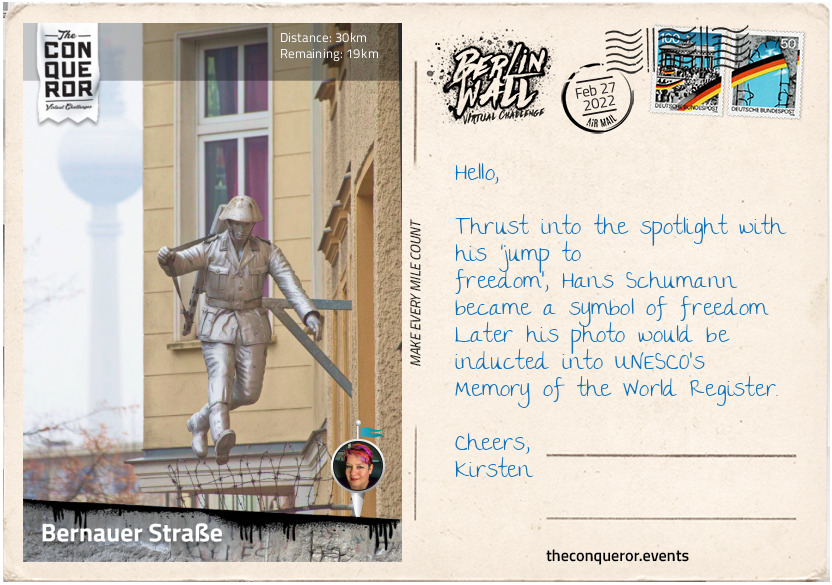
A couple of miles (3km) northeast of Brandenburg Gate is the historical Bernauer Straße (Street). When the city was divided, the wall ran along this street. Since the street belonged to France, all the windows, doors and rooftops on the southside were progressively bricked up by the East German border guards and later the buildings were demolished.
It was here that the first casualty of the Wall occurred. Ida Siekmann was a 59 year old widowed nurse. Attempting to flee, she threw a quilt and some possessions into the street and jumped from her 3rd floor (4th by North American standards) window. She was gravely injured, and died on her way to the hospital.
In 1964, a group of 34 West Berlin students began digging a tunnel beneath the street. Six months later they completed the 475ft (145m) tunnel and reached East Berlin. Over a few days, 57 people escaped, before the tunnel was discovered. It had one casualty, a border soldier who was accidentally shot by a comrade.
It is also on this street that 19 year old Hans Conrad Schumann, a border patroller, took a leap of faith and jumped over the newly installed barbed wire. In an interview, Hans recalled watching a young woman handing a bouquet of flowers to her mother over the barbed wire and apologising for not being able to cross over. Realising that he didn’t want to keep his fellow citizens imprisoned, he dropped his submachine gun and jumped. The West Berlin police were alerted and quickly arrived in a van to whisk him away to safety. His jump was captured by a photographer and the image entitled “Jump to Freedom” became a symbol of freedom. A large photo can be seen on the side of a building on Bernauer Straße and a short distance away is a sculpture attached to the side of a building.
The demolished buildings on the southside of the street were never replaced. In its place now is a memorial park commemorating the victims of the Wall and the history of the city’s division. It is a wide-open green space, filled with information boards and relics of the Wall.
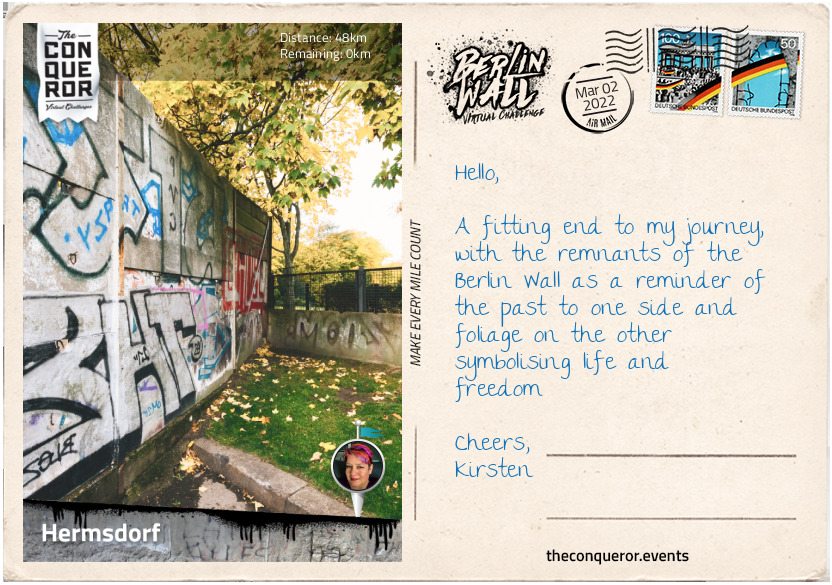
The Berlin Wall was up for 28 years, beginning with a barbed wire barrier. When it came down in 1989, it consisted of concrete blocks, mesh fencing, signal fencing, anti-vehicle trenches, barbed wire, bunkers, observation towers, spikes, electrified fences and the ‘death strip’.
Of the 5,000 people that escaped, 140 of them died trying. Reports of fatal shootings were often intentionally misreported to families with falsified death certificates issued. Families who knew what happened were threatened into silence and kept under surveillance by the Stasi (secret police). The truth for many families would only be revealed in the 1990s when the East German archives were opened for prosecution.
As quickly as the wall went up in 1961, dividing the city and separating families, it came down just as fast in 1989. Less than a year later Germany was unified. Today it is a prosperous and free country with a vibrant and cosmopolitan capital city.
I leave you with a few more short stories of bravery, ingenuity and victory:
- Fuelled by love, Heinz Meixner, a West Berlin resident in love with his East Berlin girlfriend, hired a convertible and removed its windshield and deflated the tyres to lower the car. He then drove to Checkpoint Charlie with his girlfriend and her mom hiding in the back. When his car was being checked, Heinz hit the gas pedal and drove the car beneath the steel barrier to safety in the West.
- Banned from performing due to his anti-communist beliefs, trapeze artist, Horst Klein, climbed above the border patrol guards onto disused power cables and carefully walked his way to freedom.
- Ingo Bethke and his friend silently paddled their way across the river using an air mattress as a raft. In another location, Ingo’s brother, Holger, together with a friend, shot an arrow with a line tied to it from an attic to the West. Another Bethke brother, already in the West, tied the line around a chimney and the pair ziplined across using woollen jumpers.
- Crashing through the Wall at full-throttle was Harry Deterling’s only intent. A train engineer, he hatched a plan to use a steam locomotive to smash through the crossing into the West. Bearing down on the crossing at 50mph (80kph), he disconnected the brake lines, so the locomotive couldn’t be stopped. The train came to a halt in a West Berlin neighbourhood where Harry, his wife, their four children and 26 other people safely disembarked.
I feel honoured to have walked this path and aim to always remember the hardships and losses endured, the courage needed, the heroic attempts and the sacrifices made for the sake of freedom.

